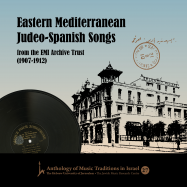(381 results found)
31. El lindo mancebo + Los amantes de la casa rica Oh! que lindo mancevo (CES)
… Attias-Alhanati (e.g. NSA, Y 09485, no. 1), have the same melody as this recording and include only the first three stanzas. This melody differs substantially from the one found on many …
27. El alma dolorida (CES)
… prelude, interlude and postlude, with stanza 6 sung to its melody. This last stanza contrasts with the first five …
26. La rosa de mayo + Los bilbilicos (CES)
… a similar version with an additional fourth stanza. The melody was adapted at an early stage to religious Hebrew …
24. El buceador (CES)
… water in the fragment of this song that she remembered. The melody in 6/8 in this recording is quite distinguishable in …
23. La palomba (CES)
… This is a parodic song based on the melody and the refrain of the famous habanera by the Spanish …
22. La galana (CES)
… version of both text (in fact only the refrain) and melody that appears to echo this recording. See also: "The …
19. El guitarrista + La firmeza de las estrellas + El enamorado engañado (CES)
… I, nos. 34, 35), have lost the rhapsodic character of the melody that is preserved in the historical recordings (see …
18. La hermosa durmiente (CES)
… of the CES is unique in that in every second stanza the melody starts from the upper register. Pedrí tresoro, bienes …
16. El pájaro de amor (CES)
… located in Hemsi’s version at the opening of the song. The melody is very similar to the one registered for the many …
15. Cinco años ya va hacer (CES)
… 1871- 1936) and published in Jerusalem in 1896/7. The melody of Cinco años ya va hacer as notated by Levy … by CES is, on the surface, musically different from the melody notated by Levy and maintained orally in the piyyut …



